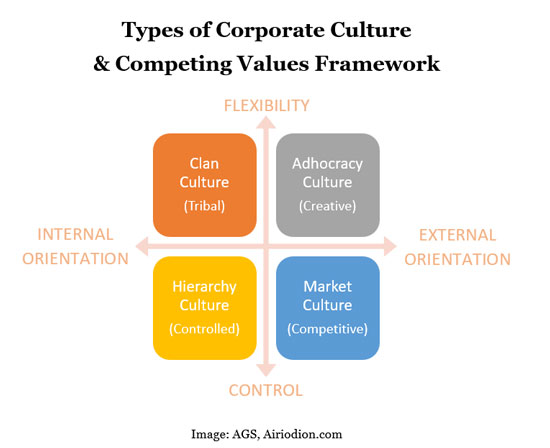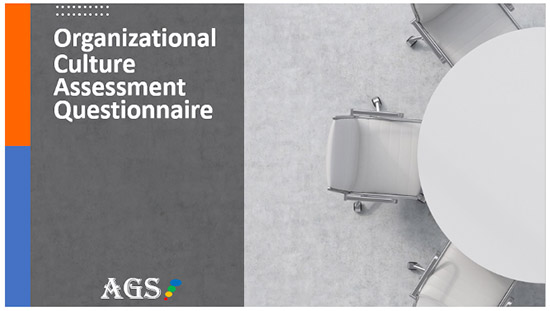How to Use a Culture Index Survey to Understand Company Culture Types
Company culture can be a source of pride or a source of a toxic environment. Assessing workplace culture is important to understand the impacts culture may be having on your bottom line and to ensure it aligns with your values.
You can define workplace culture as the shared goals, values, attitudes, behaviors, and practices that are prevalent in an organization. These factors shape how people within the organization interact and feel about their work, and how it is perceived by those outside the company.
Just because a CEO may envision having a creative and collaborative culture, doesn’t necessarily mean this is trickling down to employees. Using an organizational culture survey might reveal that employees feel locked in by a hierarchal corporate culture that stifles creativity.

Organizational Culture Assessment Tools
It’s important to use the right organizational culture assessment questions to zero in on the culture and subcultures of a company.
According to Forbes, engaged employees generate 21% higher profitability for a company. On the flip side, if employees aren’t engaged, it can cost a firm in productivity and bottom-line impacts. Workplace culture has a direct impact on how engaged staff members feel in their work.
Culture Index Survey
An organizational culture survey can be used to enter data from a culture fit assessment for analysis to ensure the existing company culture matches the needs of the organization.
A company culture assessment that gathers employee input about workplace culture is also a good way to root out any potentially toxic subcultures in the organization that are causing a negative impact on staff and profit.
See Also: Top Guide on Workplace Culture

What is a Culture Assessment?
A culture assessment is an evaluation of several factors in an organization in order to learn what culture, values, and beliefs are guiding the organization.
Whether you’re in the UK, searching on “organisational culture assessment” or in the US looking up a culture assessment survey, this can help you tell the difference between the ideal culture that’s envisioned and the real culture that exists in a company.
Companies can also have subcultures within different departments that can work for or against the overall company culture. For example, if your company values sustainability, then you may go above and beyond to only use sustainable materials in an office even if they cost more.
However, a cultural value assessment might uncover that in the maintenance department, the leadership looks at cost reduction first. Thus, their culture may be more value-driven, and using sustainable materials is frowned upon if they have a premium price.
A corporate culture assessment will be a process of gathering information about company beliefs, leadership styles, employee opinions, behaviors, and more to find out exactly what the current culture is and how to mold it to the desired corporate culture if needed.
Don’t Miss: Guide on Corporate Culture | All You Need to Know

Why is Assessing Organizational Culture Important?
You might wonder, “Why do a workplace culture assessment at all? Why not just let leaders manage according to their own styles?”
The reason is that an organizational culture and readiness assessment can uncover behaviors, values, and activities that are bad for business.
A culture index survey can also identify the factors that are making a company successful, so it knows where to focus efforts to keep its team on track.
Assessing organizational culture is important because company culture has a direct impact on business well-being, reputation, employee retention, and profitability.

Assessing Company Culture Types
Let’s look at one example where a poison company culture has significantly damaged an organization’s reputation.
In the case of Wells Fargo Bank, a culture of fear, greed, and “win at all costs” has caused the company to have multiple scandals over the last several years due to fraudulent activities that hurt its customers.
This failure to understand a pervasive and negative culture has cost the company well over $3 billion in regulatory fines and penalties.
Not all companies that fail to use an organizational culture assessment instrument (US spelling) or organisational culture assessment instrument (UK spelling) to assess their true company culture will experience that level of severity. However, a bad corporate culture can still be very costly.
Impacts of a Bad Corporate Culture
- High employee turnover
- Drops in productivity
- Poor employee morale
- Missed opportunities
- Revenue loss
- Loss of customers
- Bad corporate reputation
- Legal issues
- No forward motion
Related: Everything You Need to Know About Company Culture
What Are the 10 Characteristics of Culture in an Organization?
Before you begin putting together cultural assessment interview questions for employees, it’s vital to understand the different cultural characteristics of a company that you’ll be looking at.
Some company culture types may have less of one of the characteristics than another. But it may make up for that in another area being considered when looking at types of the corporate culture.
For example, a hierarchy-style corporate culture may be less agile, but more stable. While a more creative and relaxed corporate culture may drive more innovation but be less reliable.
It’s essential that you understand the type of workplace culture you want and that will most benefit your business before you begin using an organizational culture survey. Not all culture types fit all businesses, nor should they.
A graphic design company may champion collaboration and agility and have a creative corporate culture overall where there’s less hierarchy. And this culture may be the perfect fit.
But that same workplace culture might not be a good fit for an accounting firm, where checks and balances are there for a reason. In this case, a hierarchal culture offers better security and reassurance to clients.
When doing a culture fit assessment, there are 10 key culture characteristics to consider:
- Agility: Are employees empowered to adjust to changes in the marketplace? How rigid are company policies?
- Collaboration: Do employees work well together and are they given the tools to collaborate? Does the company’s type of business require more solitary work?
- Diversity: How well does the staff and leadership reflect the diversity of the population? Is there an inclusive environment for people of all races, religions, sexual orientations, physical/mental challenges?
- History: What pieces of the company’s history represent corporate culture? How has historical workplace culture strengthened or weakened the organization?
- Innovation: Is the company a leader or follower in its industry? Are there any programs that promote employee innovation?
- Integrity: How does the organization and its staff treat customers? Does the company prize profit over all else?
- Performance: How well are employees compensated compared to the industry? Is there an employee development program? How is lacking performance dealt with?
- Respect: Do managers and supervisors treat employees with respect, or do they just expect staff to respect them? How do employees treat each other or teams in other departments?
- Stability: Does your company always seem to be changing (software, tools, ways of doing things)? Is there a structured framework of policies and procedures in place to guide activities?
- Values: What are the organization’s core values? Does the company value customer experience overall all else? Does beating the competition at all costs win out?
When putting together culture assessment questions for assessing workplace culture, you want to keep these ten characteristics in mind.
Remember, just because you may think you know the answer to organizational culture assessment questions, don’t assume how employees perceive workplace culture is the same way you do.
You’ll want to use things like sliding scales and open-ended questions when using organizational culture assessment to survey your team. We’ll go into tips for cultural assessment interview questions shortly.
Popular Article: Implementing a Culture of Change Within an Organization

What is the Main Function of Culture?
The main function of culture in a company is to define your organizational identity, both inside and outside your organization.
Company culture assessment helps define what a company values most, thus it frames the priorities for leadership and employees.
A strong, positive company culture can promote employee engagement, a sense of team, and cause people to go above and beyond by putting forth the extra effort of their own accord because they feel valued.
For example, positive culture may cause a team to stay late to finish a client project ahead of schedule, because they want to, not because they have to.
Without an intentional company culture, you could end up with conflicting leadership styles, and no sense of common values or mission.
What are the Four Types of Corporate Culture?
When doing an organisational culture assessment in the UK or a cultural assessment survey in the US or another country, it helps to have a model by which to judge corporate culture.
One of the most popular models was developed by University of Michigan business professors, Robert E. Quinn and Kim S. Cameron. It defines four main types of the corporate culture.
These four defined types of corporate culture are:
- Adhocracy Culture (Creative)
- Clan Culture (Tribal)
- Hierarchy Culture (Controlled)
- Market Culture (Competitive)
Additionally, Quinn and Cameron defined these types of corporate culture in a culture index survey that is something like a grid. It compares where each of these cultural value assessment types are situated between four organizational parameters. This is called the Competing Values Framework.
The parameters in this framework are:
- Flexibility
- Control
- Internal Orientation
- External Orientation
When doing a culture assessment survey, organizations will most likely find they have “shades” of each of these parameters. For example, they may be halfway in between a flexibility and control culture but lean more towards internal focus than external.
Corporate culture assessment sets each of the four types of corporate culture squarely in the cross-sectional grid of each of the two opposing parameters to help give organizations an idea of where their culture strengths and weaknesses may be.

As we discussed, no one culture type is better than another. The culture that works best for a company depends upon an organization’s goals, ways of doing business, values, and business model.
When doing corporate culture assessment, the goal is to find your reality as to employee perception and behaviors and how far that is from the culture your business needs to thrive.
Each of the types of corporate culture that you may identify from a workplace culture assessment has strengths and weaknesses. Knowing these can help you take the “good parts” of a particular corporate culture and adopt it into another.
When searching in the UK for organisational culture assessment instrument or in the US for organizational culture and readiness assessment tools, you’ll often find these four company culture types being used.
Adhocracy Culture (Creative)
The adhocracy culture is one where creativity and thinking outside the box are the norms. You’ll find that innovation is valued, and organizations may even give employees free time to work on inventive projects.
This is one of the least structured company culture types, and you’ll find less hierarchy or “hoops to jump through” when it comes to contributing new ideas to make the company better.
An example of a company with an adhocracy culture would be Google. The organization is famous for inviting innovation and encourages employees to spend 20% of their time working on whatever they think will most benefit the company.
Company culture types positive/negative for Adhocracy Culture:
- Positive elements: Flexible, drives transformation, innovative
- Negative elements: Unstructured, rule-breaking, prone to mistakes
Clan Culture (Tribal)
The clan culture is one of the types of corporate culture that is very team-oriented. Employees, managers, and leadership will often feel like a big happy family. Employees are often engaged and have pride in their organization.
When doing a culture index survey of this workplace culture type, you’ll often find that emphasis is put on mentoring and employee development. There will also be very defined branding that is part of the “team” atmosphere.
HubSpot is an example of a company with a clan culture. It often highlights employee achievements, has distinct branding, and promotes team events to foster a feeling of family.
Company culture types positive/negative for Clan Culture:
- Positive elements: Collaborative, team-oriented, loyal employees
- Negative elements: Group think, less diverse, unwelcoming to outsiders
Hierarchy Culture (Controlled)
Hierarchy corporate culture emphasizes rules and structure. Ideas are weighed and measured to ensure high efficiency before implementation.
When using a culture assessment tool to review this culture, you’ll most likely find a detailed onboarding process for new employees. This type of culture also has stability that can be comforting to both employees and clients.
An example of an organization with a hierarchy structure would be Prisma Health. Like many other healthcare providers, it has a defined structure and framework of policies and procedures, including a governance board. This ensures the best quality of patient care.
Company culture types positive/negative for Hierarchy Culture:
- Positive elements: Fewer mistakes, reliability, efficiency
- Negative elements: Slower to change, less innovation, inflexible
Market Culture (Competitive)
The market culture is competitive and driven by results. You’ll often find when assessing organizational culture, that a sales department may have a subculture of this type.
Success and winning are the measurements of employee performance and the environment can be a demanding one. Market share and penetration are prized, and top performers will typically be rewarded well.
Amazon is an example of a company with market culture. The company is continually optimizing everything from warehouse operations to customer website journey with profitability in mind.
Company culture types positive/negative for Market Culture:
- Positive elements: Fast to react, results-driven, customer-focused
- Negative elements: Demanding, profit over people, reactive
Read More: Best Change Impact Assessment
How Do You Assess Company Culture?
A culture fit assessment or organizational culture survey involves gathering information from multiple sources about your company.
A common organizational culture assessment instrument used in a company culture assessment is an employee survey. Organizational culture assessment questions can be very helpful for digging into how employees see their workplace environment.
The organizational culture survey is just one of the ways to assess company culture. There are others as well, such as behavior monitoring and exit interviews.

Assessing Company Culture Types
Here are some of the organizational culture assessment tools you can use when assessing workplace culture.
Cultural Assessment Interview Questions
A great way to get some perspective on your company from the outside is to add in some organizational culture assessment questions when you’re interviewing for new positions.
This will give some insight into how those outside your organization perceive your company culture. Insight from job candidates can alert you to some positive (or negative) aspects of workplace culture assessment you weren’t aware of.
Examples of cultural value assessment questions you could ask along with other interview questions are:
- What things about our company made you choose to apply?
- How did you envision our work culture when you visited our website?
- What is your favorite thing about our company?
Cultural Assessment Survey of Employees
You can gather a lot of valuable information using a cultural assessment survey and asking employees a variety of questions about their working environment, how they feel about their work, and how they feel about the company.
A culture index survey gives you insight into any subcultures in your organization and where things are going right or going wrong.
This type of organizational culture assessment can be done in person with small groups or one-on-one. It can also be done as an anonymous survey that employees can fill out online or in a survey document.
Behavior Monitoring
Corporate culture assessment can also be done by monitoring behavior and looking for any signs of a toxic culture. Such as employee conflicts, raised voices, or lack of engagement.
When in the UK and doing organisational culture assessment or in the US doing an organizational culture and readiness assessment, quietly monitoring the day-to-day activities and behaviors of teams can tell you a lot about workplace culture.
Exit Interview Culture Index Survey
When employees are retiring or have decided to move on, you can gain valuable knowledge about your company in an exit interview.
A benefit of this type of organisational culture assessment instrument (UK spelling) or organizational culture assessment instrument (US spelling) is that employees may be more forthcoming with their honest opinion because they are leaving and don’t have anything to lose.
Tips for Planning an Organizational Culture Survey
When assessing organizational culture, it’s essential to set your questionnaire up for success. This means creating a culture index survey that will be easy for employees to fill out and invite them to give input in a number of workplace areas.
Here are some tips for planning this organizational culture assessment instrument:
- Include a mix of different questions (open-ended, sliding scale, multiple choice)
- Keep questions short and to the point
- Don’t make the survey too long
- Use a friendly tone to invite engagement
- Include graphics and images for visual interest
Free Culture Assessment Survey to Send Employees
Are you looking for help assessing organizational culture? AGS has put together a list of organizational culture assessment questions that you can send your employees.
Our downloadable PPT and PDF questionnaire includes a variety of different question types written comprehensively. It is designed as a tool to make your culture index survey process easier.
If you want to send out all the questions as they are, download the PDF version of this culture assessment tool. If you’d like to edit the questions, download the PPT version of this culture fit assessment survey.

Download PPT – Culture Index Survey for Employees
Download PDF – Culture Index Survey for Employees

Conclusion | Best Organizational Culture Assessment Guide
Company culture impacts multiple areas of an organization. This includes everything from how collaborative your staff is to how well your customers are taken care of. It’s important for organizations to know their true company culture because it’s driving behaviors on a day-to-day basis.
The types of corporate culture considered positive for a business will vary according to industry type, mission, and values. But for all companies, assessing organizational culture is vital to your bottom line and continued success.
Using an organizational culture survey can take the pain out of what could otherwise be a time-consuming process. It offers guides, ready-to-go questionnaires, and analytical insights.
Your company has a culture whether you use a culture index survey to define it or not. It’s much better to have control of your culture so you can mold it, rather than have a toxic culture hurting your bottom line.
Organizational Culture Assessment Instrument FAQ
What is a cultural assessment?
A cultural assessment is an evaluation of several factors in a company in order to learn what culture, values, and beliefs are guiding the organization.
How do you assess the company culture?
An organizational culture assessment involves gathering information from multiple sources about your company.
A common organizational culture assessment instrument is an employee survey. Organizational culture assessment questions can be very helpful for digging into how employees see their workplace culture.
The organizational culture survey is just one of the ways to assess company culture. There are others as well, such as behavior monitoring and exit interviews.
What are the 10 Characteristics of Culture?
When doing a company culture assessment, there are 10 key culture characteristics to consider:
1. Agility
2. Collaboration
3. Diversity
4. History
5. Innovation
6. Integrity
7. Performance
8. Respect
9. Stability
10. Values
What is the main function of culture?
The main function of culture in a company is to define your organizational identity, both inside and outside your organization.
Company culture assessment helps define what a company values most, thus it frames the priorities for leadership and employees.
A strong, positive company culture can promote employee engagement, a sense of team, and cause people to go above and beyond by putting forth the extra effort of their own accord because they feel valued.
Note: Content on OCM Solution's ocmsolution.com website is protected by copyright. Should you have any questions or comments regarding this OCM Solution page, please reach out to Ogbe Airiodion (Change Management Lead) or the OCM Solutions Team today. OCM Solution was previously known as Airiodion Global Services (AGS).
Images: https://www.pexels.com/photo/photo-of-people-doing-fist-bump-3184430/, https://www.pexels.com/photo/people-working-in-a-call-center-5453837/, https://www.pexels.com/photo/two-woman-chatting-1311518/, https://www.ls.graphics/free/free-pixel-4-and-pixelbook-go-mockup

